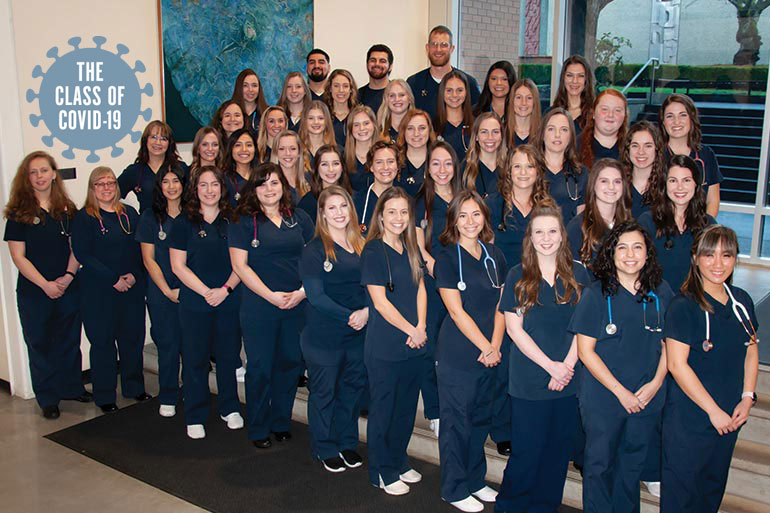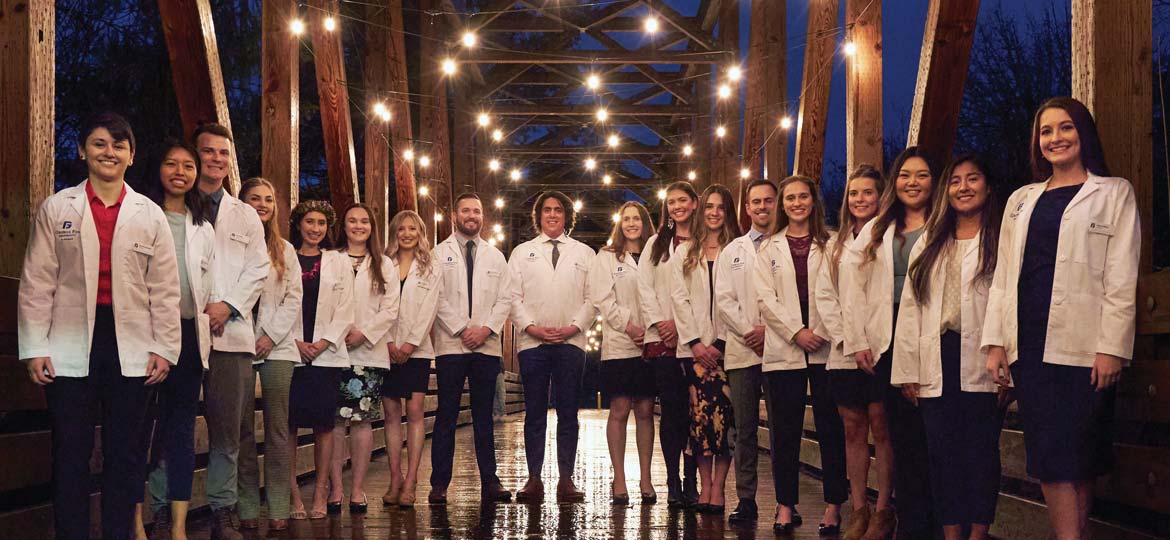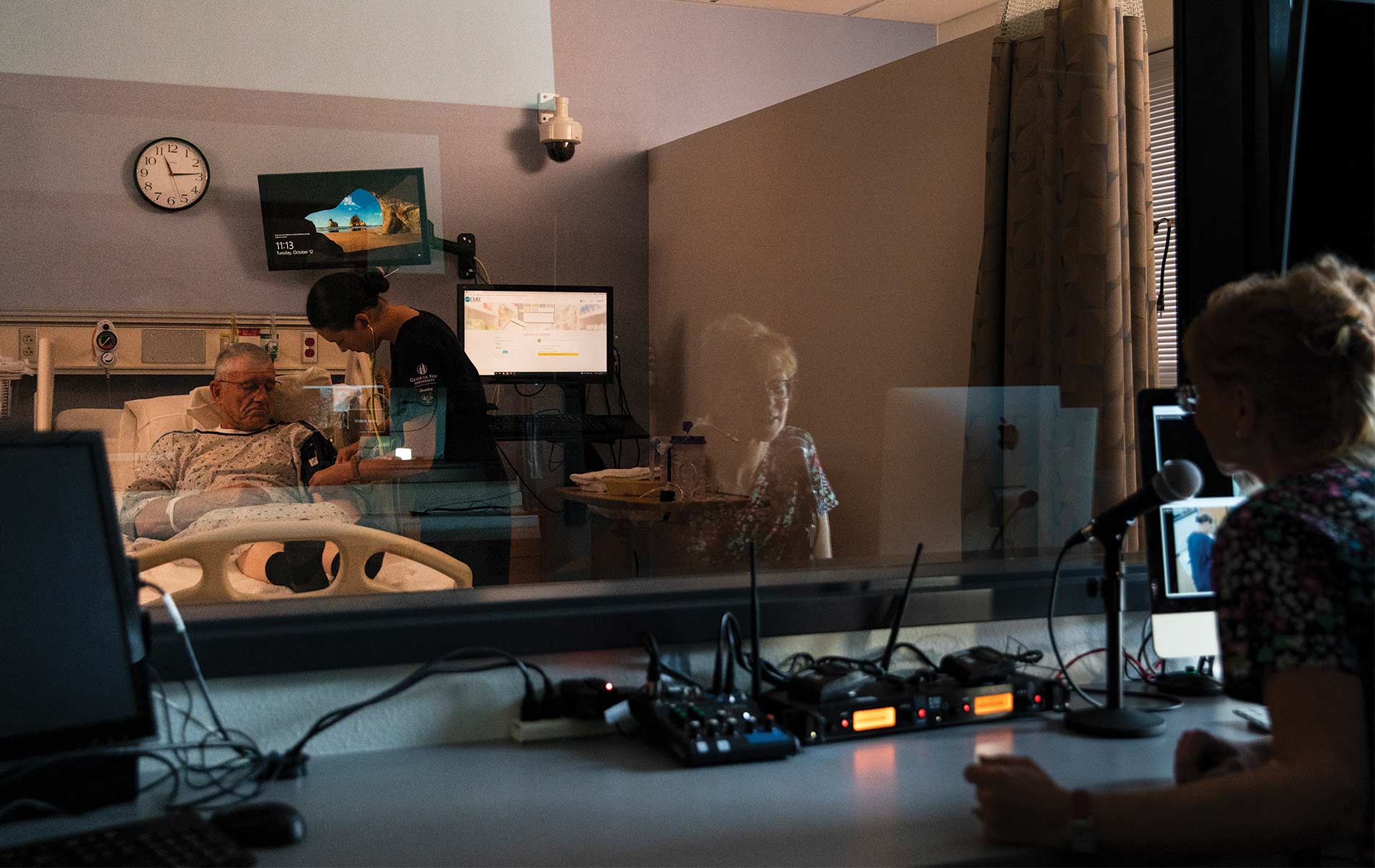
A New Approach to Nursing Education
Fox Health allows nursing students to gain invaluable real-world experience in a controlled environment
Aman hobbles barefoot down the hallway in a mint-green gown. One hand clutches two flimsy pieces of fabric that keep the garment from flying open in the back while the other firmly grasps the doorway of the room he is about to enter. Above his head, the faint, familiar buzzing of fluorescent lights can be heard. Climbing onto a bed, the patient gives a thumbs-up to the long, rectangular mirror directly across from him. Like clockwork, two nurses walk in. The man smiles at the nurses and proceeds to show them what appears to be a deep, colorful gash in the middle of his left shin.
After noting that the patient’s pain level has risen from a three to a six, one of the nurses places a few pills into a cup. Suddenly, the patient leans back into his bed and grimaces. His whole body constricts as he bites down on his lip and his hands grip the sheets. Immediately, the nurses jump into action, taking vital signs and scribbling down notes before stepping aside and talking with each other. They think the man is beginning to develop a staph infection.
In the neighboring room, a woman sits behind multiple computer screens, peering through the one-way mirror into the patient’s room. She nods in approval, adjusting her glasses while leaning into a microphone on her desk. She utters a few words and the patient immediately relaxes, his smile returning as he hops off the bed and walks straight out the door.
‘Immersed in the Simulation’
While this plot twist may seem like it’s straight out of a movie, it’s actually part of a simulation for George Fox nursing students. Housed in the university’s Roberts Center – which, ironically, used to be a hospital – a new state-of-the-art facility called Fox Health allows nursing students to experience real-world healthcare scenarios under the watchful eye of professors.
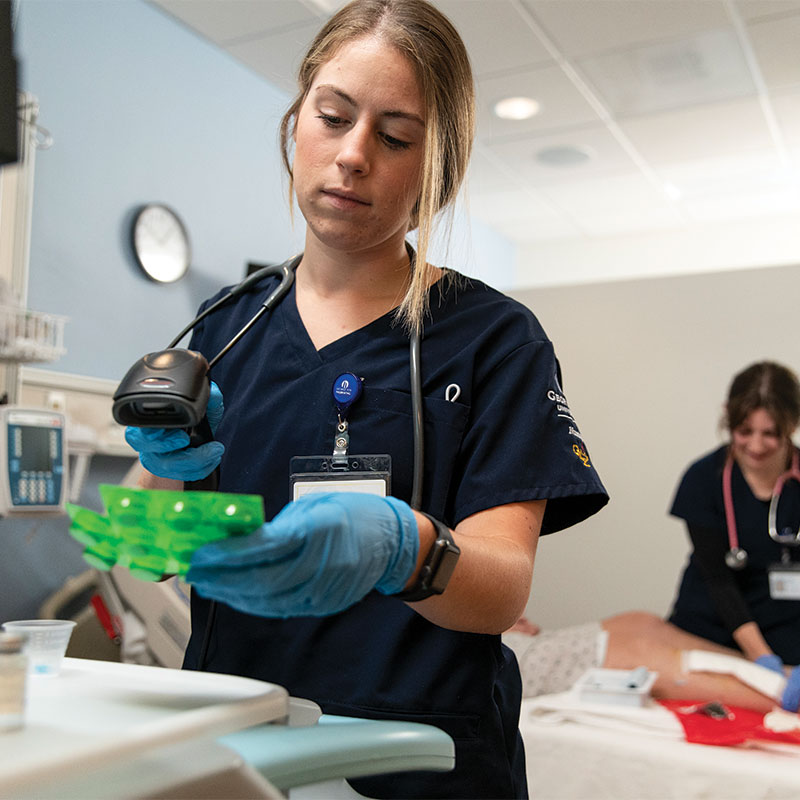
Nursing students treat a “patient” actor in one of the Fox Health simulation rooms.
Fox Health is made up of three separate facilities: the Skills Lab, the Home Health Room and the Simulation Center. Each is meant to provide students with an immersive learning experience, which is why every aspect of Fox Health, down to the handrails and floor tiles, was designed to replicate a real-life hospital. There is a nursing station and a fully stocked supply closet. Even the patient rooms are outfitted with all the knobs and gadgets that would be used in an actual hospital.
“We wanted to make it as realistic as possible,” says Pam Fifer, dean of the College of Nursing, whose 25 years of experience in the nursing profession proved invaluable to the design of the facility. “We want students to feel like they are immersed in the simulation – that they are a part of a real functioning hospital.”
In a “sim,” students have the opportunity to be in charge – to ask questions, take vitals and develop their clinical judgment skills. Fox Health is centered around this idea of ownership, which is often in sharp contrast to clinicals, the portion of nursing school where students are placed in hospitals to gain hands-on experience.
Sometimes, due to the nature of a real operating hospital, nursing students can be pushed aside or overlooked entirely. There can also be a great deal of apprehension as a student nurse works to apply knowledge gained in the classroom to an actual hospital setting for the first time. Unlike clinicals, sims allow students to be the sole decision makers for their patients, and if those decisions are wrong, to fail, learn and try again – all with a safety net.
The Human Element
While the Fox Health Simulation Center boasts several high-fidelity simulation rooms with high-tech equipment, it’s the presence of patient actors that makes the experience seem real.
In each room, “patients” are instructed to describe specific symptoms, such as coughing, physical pain, cuts or bruises. And because the sims are comprised of three to four scenarios, students learn to see the consequences of their actions.
If a student misses a patient’s blood pressure dropping, then suddenly spiking, the subsequent simulation will result in that patient going into septic shock. It’s the job of the simulation operator, usually a clinical instructor who observes from a control room, to direct how the scenarios play out according to the student’s actions.
For future nurses, understanding the consequences of each action is key to gaining confidence and growing in their knowledge and clinical judgment. “I am able to learn because I am the one taking responsibility for what is going on,” says Whitney Mayworth, who will enter her senior year in the program this fall.
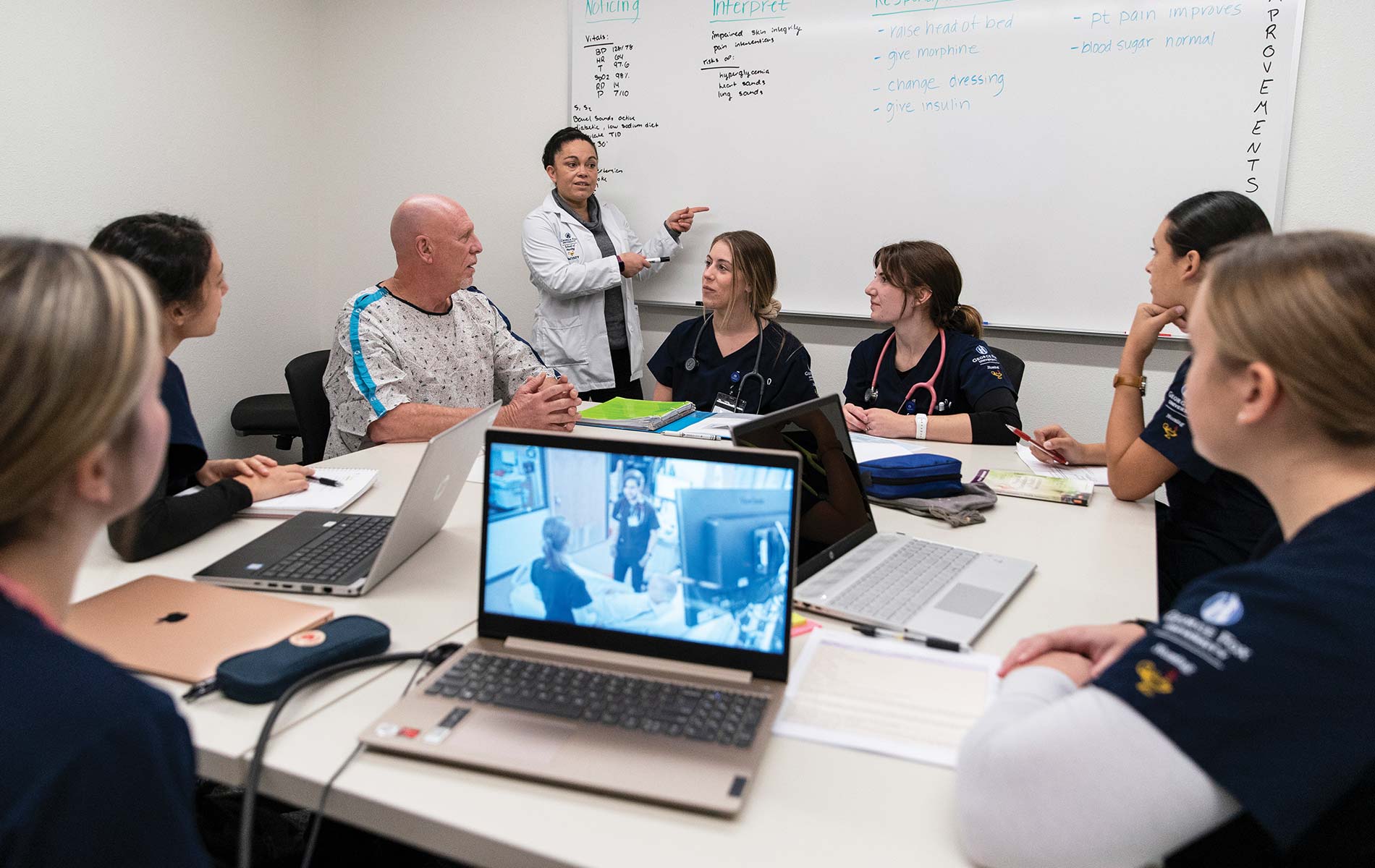
Nursing students debrief with a professor and the “patient” after a simulation.
Sims also allow professors to gain insight into a student’s thought process and to either affirm or correct it. “Sometimes we watch students do the right thing, but if we don’t ask them why then they may be doing it for the wrong reason,” Fifer explains.
That’s why each sim is followed by a debriefing session, during which students explain and reflect on their decisions, diving deeper into the consequences of each action with a professor.
For Mayworth, the sims and subsequent debriefing sessions are irreplaceable. “While the patients are not real, I know that whatever I am doing now is going to affect the care I give a real patient later, so each time I feel like I should be doing my best,” she says.
At the Fox Health facility, students benefit not just from doing, but from watching their classmates participate in sims and taking part in the debriefing discussion afterward.
“Sims get you comfortable asking the really hard questions,” says Claire Williamson, a 2021 nursing program graduate. “It’s also a great space to see how your peers handle things and to be able to learn from everyone else.”
Beyond the Simulation Center
The Simulation Center isn’t the only environment within Fox Health where future nurses can practice what they have learned in a safe environment. Located right next door, the recently redesigned Skills Lab is outfitted with nine beds that allow students to practice their bedside manner, professionalism and assessment skills.
Here, students can act out scenarios with each other or can use one of many mannequins that can simulate breathing, crying out, vomiting, bleeding and more. By practicing their skills on the mannequins, students are able to develop the critical muscle memory required of certain procedures before practicing on real patients.
“In the Skills Lab, we can guarantee what students are going to see, as opposed to off-campus clinicals which are more haphazard because we don’t know what kinds of patients they are going to encounter,” Fifer says.
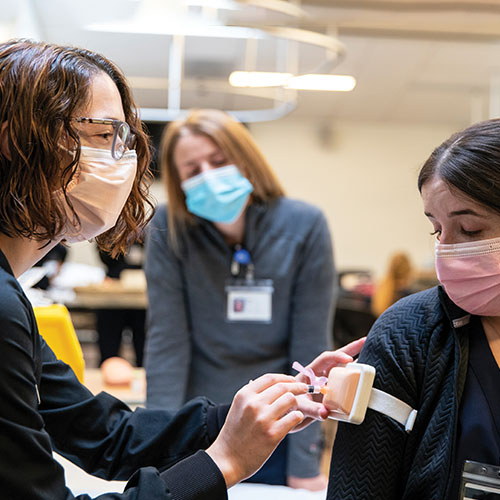
Creating controlled scenarios that were previously left to chance at a clinical location allows Fox Health proctors to curate specific scenarios that they deem most important for learning. This became especially important during the peak of the COVID-19 pandemic, which resulted in limited clinical placements, making it a challenge for students to meet the clinical hours needed to graduate. Now, with access to the Simulation Center and revamped Skills Lab, students can gain the hands-on practice they need to develop clinical competence – ensuring the pipeline of future nurses does not stall.
Likewise, the Home Health Room allows nursing students to experience a wide variety of potential settings and scenarios within the profession, such as telehealth, home visits and hospice care. It also gives them the opportunity to work through a wide variety of micro-ethical issues, like how to handle stressful family dynamics that are often a part of in-home care.
“We must prepare students well for their profession, which has a high turnover and burnout rate, while they are still protected and have a safety net,” Fifer says.
Looking to the Future
From classroom theory to simulation, to feedback and group discussion, to practicing new skills and asking hard questions, all elements of the Fox Health facility come together to create an environment where nurses are prepared to not just survive, but thrive in their profession – at a time when they are needed more than ever.
Considering the high rate of turnover and burnout for nurses, Fifer sees these sims as essential to preparing skilled nurses who not only stay in their profession, but become leaders in it.
“We want our students to treat every patient with dignity and respect – to treat them as Christ would,” she says. “After all, sooner or later they will be taking care of all of us.”
Looking for more?
Browse this issue of the George Fox Journal to read more of the stories of George Fox University, Oregon's nationally recognized Christian university.
